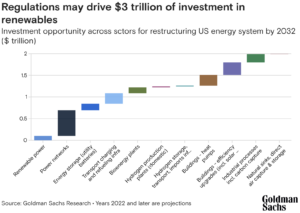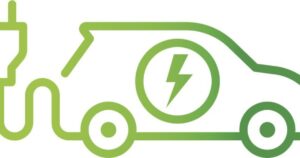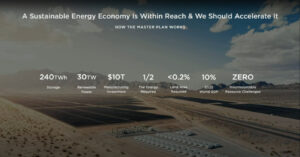
In case you don’t have the date marked on your calendar like I do, the Inflation Reduction Act (IRA) is about to celebrate its one-year anniversary as a federal law! (Insert cheers and biodegradable confetti here.) As we get closer to the actual day (Aug. 16), I will be taking a closer look at the impacts of the legislation, both felt and still anticipated.
So today, we’ll explore how the IRA’s incentives will affect emissions reductions from emerging technologies through the rest of the century.
Last week, the Rhodium Group released a report that analyzes the future emissions reductions impacts of three emerging climate technologies – sustainable aviation fuel, clean hydrogen and direct air capture – from 2030 all the way to 2100.
I know what you’re thinking: Any model that claims it can accurately predict the scope of emissions reductions in 2100 via nascent technologies of today sounds questionable at best. That was my reaction, too. And it’s valid!
What caught my attention about the report was the methodology behind the predictions — mainly, the use of the Emerging Climate Technology Framework.
Emerging Climate Technology Framework
Back in January, the Rhodium Group released its Emerging Climate Technology Framework (ECTF), a model that, ostensibly, assesses the long-term impact of emerging technologies on global emissions by tracking that technology’s path to price parity in the marketplace.
All of that jargon means the ETCF model uses market conditions available today to predict how quickly the technology will develop and become accessible to the general market. It then connects market availability to emissions reductions. And the ECTF model uses the steps previously established in the solar technology marketplace as precedent.
- Early investments in solar tech accelerated the development of solar panels;
- As solar panels became more effective, more people and companies wanted to purchase them, driving down the cost to the once-nascent technology;
- As cost reductions continued, worldwide deployment of solar panels increased;
- Conversely, emissions decreased as this renewable energy tech became widely available.
ECTF and the IRA
So, using the ECTF model as the guiding framework, the Rhodium Group’s recent report analyzed the impacts of IRA policy incentives on clean hydrogen (the 45V tax credit), sustainable aviation fuel (Section 45Z) and direct air capture (45Q tax credit).
The results were as follows:
- A potential reduction of carbon emissions by 99 million to 193 million metric tons per year between 2030 and 2050;
- Climate tech cost reduction leads to deployment in the U.S., which in turn accelerates global deployment of the three technologies, leading to an additional 65 million metric tons reduction in carbon emissions;
- By 2080 to 2100, the IRA’s incentives are driving a global carbon dioxide abatement of 401-847 million metric tons.
These ranges are meant to illustrate to policymakers the impact of the IRA as it stands today. Obviously, laws are amended, markets change and unforeseen scenarios arise. This model isn’t meant to provide a definitive answer for the future. Rather, it shows what is possible as of today, as well as how much further we can go if we create more climate tech incentives.
[Want more great analysis of climate tech and innovation? Sign up for Climate Tech Rundown, our free email newsletter.]
- SEO Powered Content & PR Distribution. Get Amplified Today.
- PlatoData.Network Vertical Generative Ai. Empower Yourself. Access Here.
- PlatoAiStream. Web3 Intelligence. Knowledge Amplified. Access Here.
- PlatoESG. Automotive / EVs, Carbon, CleanTech, Energy, Environment, Solar, Waste Management. Access Here.
- BlockOffsets. Modernizing Environmental Offset Ownership. Access Here.
- Source: https://www.greenbiz.com/article/impact-ira-100-years
- :is
- $UP
- 100
- 16
- 2030
- 2050
- 65
- a
- About
- accelerated
- accelerates
- accessible
- accurately
- Act
- actual
- Additional
- affect
- AIR
- All
- an
- analysis
- analyzed
- analyzes
- and
- Anniversary
- answer
- Anticipated
- any
- ARE
- arise
- AS
- At
- attention
- Aug
- availability
- available
- aviation
- BE
- became
- become
- behind
- BEST
- between
- both
- by
- Calendar
- CAN
- capture
- carbon
- carbon dioxide
- carbon emissions
- case
- caught
- celebrate
- Century
- change
- cheers
- claims
- Climate
- closer
- Companies
- conditions
- connects
- continued
- Cost
- cost reduction
- create
- credit
- Date
- day
- definitive
- deployment
- develop
- Development
- direct
- do
- Dont
- down
- driving
- Effective
- emerging
- emerging technologies
- Emissions
- energy
- established
- explore
- Federal
- follows
- For
- Framework
- Free
- from
- Fuel
- further
- future
- General
- get
- Global
- Go
- great
- Group
- Group’s
- Have
- here
- How
- HTTPS
- hydrogen
- i
- if
- Impact
- Impacts
- in
- Incentives
- increased
- inflation
- Innovation
- Investments
- IRA
- IT
- ITS
- January
- jargon
- jpg
- Know
- Laws
- leading
- Leads
- Legislation
- like
- long-term
- Look
- mainly
- marked
- Market
- market conditions
- marketplace
- Markets
- means
- meant
- Methodology
- metric
- million
- model
- more
- much
- my
- nascent
- Newsletter
- of
- on
- our
- panels
- parity
- path
- People
- per
- plato
- Plato Data Intelligence
- PlatoData
- policy
- policymakers
- possible
- potential
- Precedent
- predict
- Predictions
- previously
- price
- provide
- purchase
- quickly
- rather
- reaction
- recent
- reduction
- reductions
- released
- Renewable
- renewable energy
- report
- REST
- Results
- Rhodium
- s
- scenarios
- scope
- Section
- Shows
- sign
- solar
- solar panels
- stands
- Steps
- Still
- sustainable
- sustainable aviation fuel
- taking
- tax
- tax credit
- tech
- Technologies
- Technology
- that
- The
- The Future
- Them
- then
- Thinking
- this
- three
- Through
- to
- today
- tons
- too
- Tracking
- TURN
- u.s.
- unforeseen
- use
- uses
- using
- via
- want
- wanted
- was
- Way..
- we
- week
- WELL
- were
- What
- What is
- which
- widely
- will
- worldwide
- year
- years
- you
- Your
- zephyrnet











